| Site Contents by Subject |
Home Research Revelation Reconciliation |
|
Publications |
Site Map Contents in Alphabetical Order |
This Site |
|
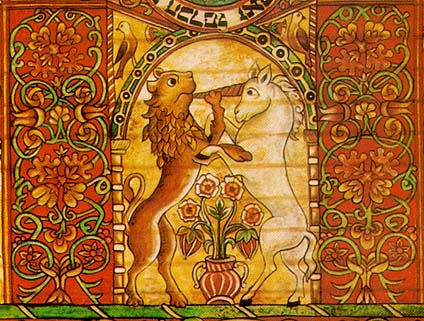 |
Detail from synagogue ceiling, in Hodorov (in Poland?),
17th-c. replication. |
Unicorns Did Exist!!
by Yair Davidiy (on behalf of Brit-Am).
Contents:
Introduction.
The Unicorn in the Bible.
Ancient Possibilities.
Aurochs.
How Many Horns Did the Unicorn [Raem] Really Have?.
The Classical Rabbinical Opinion.
The Ancient World.
The Narwhal.
The Black Obelisk of Shalmaneser.
Sakea.
Talmudic Sources.
The Unicorn in the Prophecy of Bilaam.
The Unicorn Represents Joseph.
The Unicorn: Intermediate Conclusion.
Brit-Am Significance.
| Site Contents by Subject |
Home Research Revelation Reconciliation |
|
Publications |
Site Map Contents in Alphabetical Order |
This Site |
|
 |
Detail from synagogue ceiling, in Hodorov (in Poland?),
17th-c. replication. |
Expanded and adapted from: |
| The Bible mentions unicorns. Israelites are identified by a lion and a unicorn such as appears on the British coat of arms. The Scottish coat of arms depicts two unicorns. An analysis of Biblical passages, archaeological findings, Rabbinical and other sources, indicates that there once was a one-horned creature who gave rise to our image of the unicorn. Duration: 16.46 minutes. To Continue Reading the Article Please Scroll Down! |
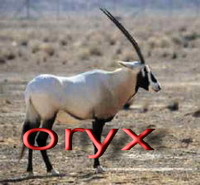 |
We shall see that the term 'Raem' was in effect eventually applied to almost any
horned animal though the Biblical usage does indicate a unicorn. |
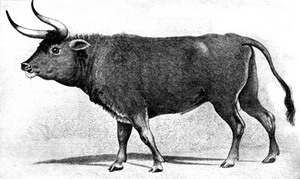 The Augsburg aurochs. This painting is a copy of the original that was presented by a merchant in Augsburg (Germany) in the 19th century. The original probably dates from the 16th century. |
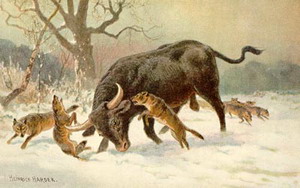 The Aurochs by Heinrich Harder (1858-1935). |
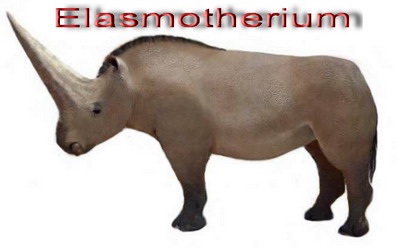 |
# Auroch (species Bos primigenius), extinct wild ox of Europe, family Bovidae (order Artiodactyla), from which cattle are probably descended. The aurochs survived in central Poland until 1627. The aurochs was black, stood 1.8 m (6 feet) high at the shoulder, and had spreading, forward-curving horns. Some German breeders claim that since 1945 they have re-created this race by crossing Spanish fighting cattle with longhorns and cattle of other breeds. Their animals, however, are smaller and, though they resemble the aurochs, probably do not have similar genetic constitutions. The name aurochs has sometimes been wrongly applied to the European bison, or wisent (Bison bonasus). #
 Toyafat (Numbers 23:22). |
HE HATH AS IT WERE THE STRENGTH [Hebrew: TOYAFOTH] OF AN UNICORN [Numbers
23:22]. |
# HIS HORNS ARE LIKE THE HORNS OF UNICORNS (Deuteronomy 33:17). It is intended to mean that his horns are like the horns of (several) unicorns for the Raem has only one horn. [Psalms 29:6] HE MAKETH THEM ALSO TO SKIP LIKE A CALF; LEBANON AND SIRION LIKE A YOUNG UNICORN. [Psalms 22:21] SAVE ME FROM THE LION'S MOUTH: FOR THOU HAST HEARD ME FROM THE HORNS OF THE UNICORNS, i.e. A wild beast of the wilderness, extremely strong.
Below is a seal from the Bronze Age Harappa Civilization on the Indus River in India. 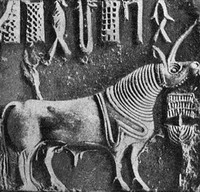
|
Here is an image from the region of Mesopotamia, probably Assyria. 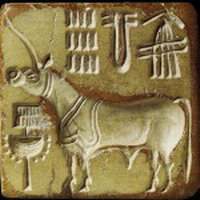
|

|
The Narwhal is a small whale up to 15 feet long with a tusk that grows in a spiral up to 10 feet long. 'Broken tusks or tusks of dead narwhal can sometimes be found on beaches'. 'Tusks of wooly mammoths, dug out of the ground were also sometimes passed off to unsuspecting buyers as unicorn horns'. Cups reputedly made of unicorn horn but actually made of rhinoceros horn or narwhal tusk were highly valued by important persons in the Middle Ages as a protection against poisoned drinks. |
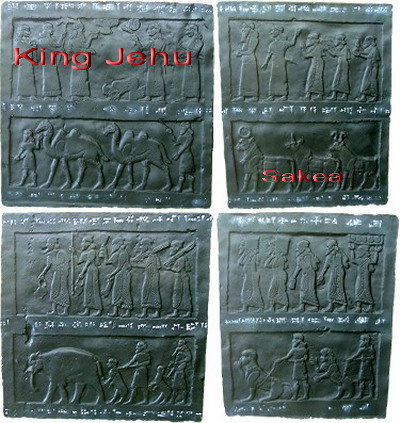
|
The Black Obelisk of Shalmaneser is famous since it depicts King Jehu of Israel making supplication. 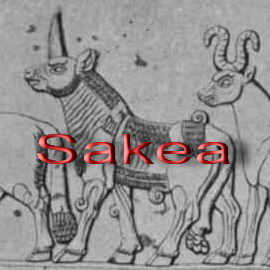
|
The Black Obelisk records the exploits of the Assyrian king Shalmaneser III (r. 858-824 BCE). It was discovered by the Englishman, Sir Austen Henry Layard, in 1846, during a large scale excavation at Nimrud, an ancient site located south of Baghdad, in modern-day Iraq. The Black Obelisk has four sides, each with 5 picture panels interspersed with cuneiform inscriptions; there is also cuneiform above and below each set of pictures. The inscriptions record the annals of thirty-two years of Shalmaneser's reign. The Black Obelisk became famous when it was realized that it made reference to Jehu, King of the Israelites. who is mentioned in the Old Testament (2 Kings 9-10). A descendant of Shalmaneser, Shalmaneser-V, is mentioned in 2 Kings 17:3 and 18:9. The Black Obelisk also mentions King Hazael of Damascus who appears in the Old Testament (2 Kings 8:28f; 9:14f). Most of the illustrations record the tributes brought to Shalmaneser by various vassal kings. The second panel depicts Shalmaneser receiving tribute from Jehu, king of Israel, who is prostrate before the king. Shalmaneser holds a bowl in his raised hand and is sheltered by a parasol held by an attendant. The tribute of the country of Musri is illustrated on the third panel. This consists entirely of animals led or driven by attendants dressed in knee-length garments.
# The legs of the creature are not different from the ones of the antelope or the buffalo. This looks odd, since the artist was seemingly able to observe the difference between the elephant's legs and those of the other animals. It is also hairy, which a rhinoceros is not! ...it is not the representation of a real animal at all, but at best what in the heraldic is to be held as an unicorn. Maybe the Assyrian artist felt indebted to an iconographic convention concerning the representation of a 'sakea'? #
#The typology of the unicorn is said among heraldists to have come about as a result of observations of wild antelope in Syria and Palestine. When viewed from the side, the two long horns of these animals give the illusion of a single horn. There are plenty of such representations in Assyrian art. It must be borne in mind that re'm or re'em (Assyrian rumu), rendered by 'monokeros' in the Septuaginta, may perhaps be the oryx. Thus the most probable reading of sakea, once one has forgot the presumed Egyptian connection, ought be 'oryx' or 'wild ox'.
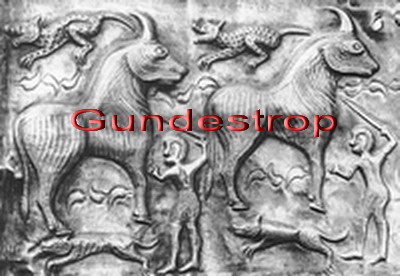
|

|
The Sakea in the Assyrian Depiction and the one-horned creatues from Grundestrup, Denmark, look similar despite the centuries of time and great geographical distance between the two. The Grundestrup beasts look a little more like horses than the Assyrian ones but not overduly so. |
The Coat of Arms of Britain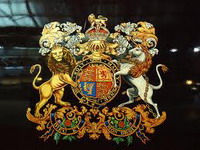 |
The Coat of Arms of Scotland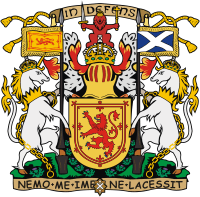 |
Depictions of John Bull meaning England.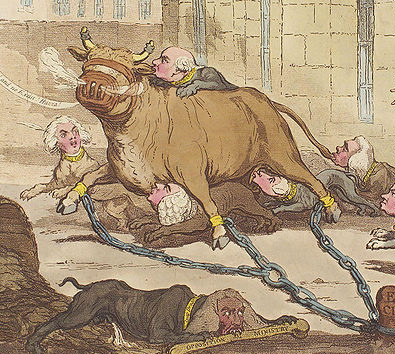
|
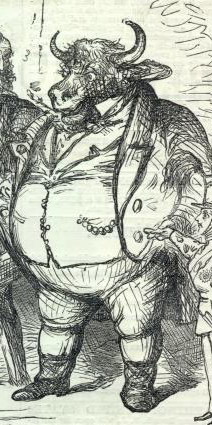 |
The Coat of Arms of Scotland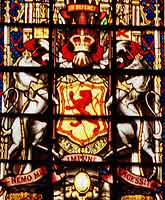 |
The Coat of Arms of Scotland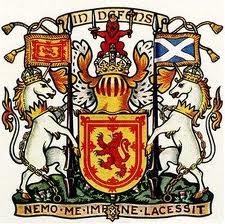 |
The Coat of Arms of Britain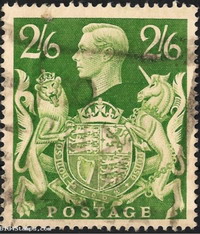 |
The Coat of Arms of Britain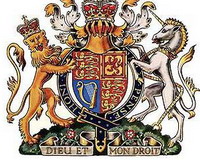 |
The Coat of Arms of Scotland |
The Coat of Arms of Canada |
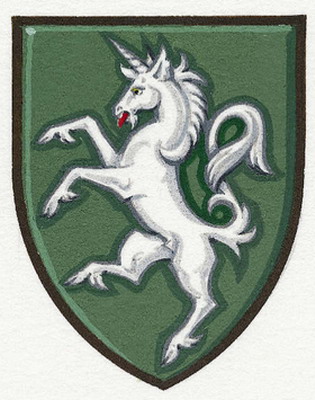 |
There are different types of horned animals that in profile seem to have only
one horn. Animals that really did have only one horn also existed. Our
impression is that there were several of them. |
Correspond with us
Send Comments or Criticisms
You may not always receive an immediate answer
but anything you say will be considered and appreciated
Send us an
e-mail
Books and Offering Opportunities
Main Page